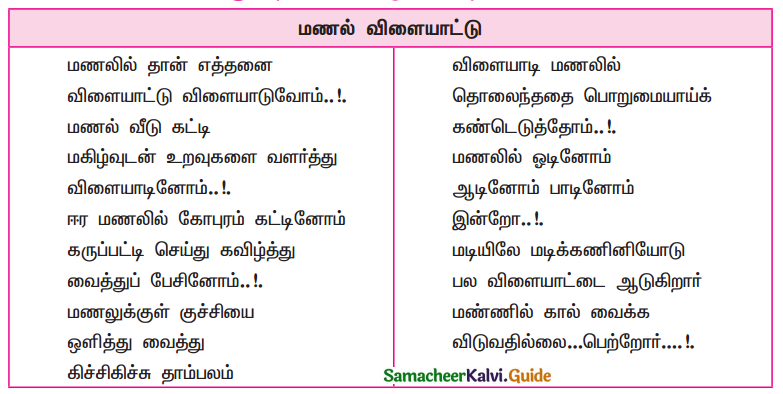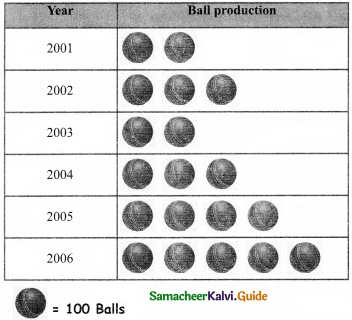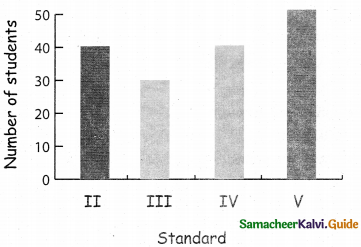Tamilnadu State Board New Syllabus Samacheer Kalvi 8th Social Science Guide Pdf History Chapter 6 Development of Industries in India Text Book Back Questions and Answers, Important Questions, Notes.
Tamilnadu Samacheer Kalvi 8th Social Science Solutions History Chapter 6 Development of Industries in India
Samacheer Kalvi 8th Social Science Development of Industries in India Text Book Back Questions and Answers
I. Choose the correct answer.
1. Which of the following activities of the people will not come under handicraft?
a) Carving statues out of stone
b) Making bangles with glass
c) Weaving silk sarees
d) Smelting of iron
Answer:
d) Smelting of iron
2. The oldest industry in India was industry.
a) Textile
b) Steel
c) Electrical
d) Fertilizers
Answer:
a) Textile
3. The woollen and leather factories became prominent in
a) Bombay
b) Ahmadabad
c) Kanpur
d) Dacca
Answer:
c) Kanpur
4. What was the aim of first Three Five year Plans of India?
a) To control population growth
b) To reduce illiteracy rate
c) To built a strong industrial base
d) To empower the women
Answer:
c) To built a strong industrial base
5. What was not the reason for the decline of Indian Industries?
a) Loss of royal patronage
b) Competition of machine made goods
c) Industrial policy of India
d) Trading policy of British
Answer:
c) Industrial policy of India
II. Fill in the blanks.
1. ………………. was the integral part in the life of the people.
Answer:
crafts
2. Industrial revolution took place in ………………. .
Answer:
England
3. The Assam Tea Company was founded in ………………. .
Answer:
1839
4. Jute industry was started in the Hoogly Valley at ………………. near Calcutta.
Answer:
Rishra
5. ………………. shortened the distance between Europe and India.
Answer:
Suez canal
III. Match the following.
| 1. Tavernier | a) Drain Theory |
| 2. Dacca | b) Paper mill |
| 3. Dadabai Naoroji | c) Artisan |
| 4. Ballygunj | d) Muslin |
| 5. Smiths | e) French traveller |
Answer:
| 1. Tavernier | e) French traveller |
| 2. Dacca | d) Muslin |
| 3. Dadabai Naoroji | a) Drain Theory |
| 4. Ballygunj | b) Paper mill |
| 5. Smiths | c) Artisan |
IV. State True or False.
1. India was famous for cotton and silk cloths.
Answer:
True
2. The railway was introduced in India by the British.
Answer:
True
3. Steel was first manufactured by modem methods at Jamshedpur.
Answer:
False
4. The Industrial policy of 1948, brought mixed economy in industrial sector.
Answer:
True
5. The tenth and eleventh five-year plans witnessed a high growth rate of Agricultural production.
Answer:
False
V. Consider the following statements and tick the appropriate answer.
1. Which of the following statements are correct?
i) According to Edward Baines, ‘The birthplace of cotton manufacture is in England’.
ii) Before mechanised industry handicrafts were the second-largest source of employment in rural India.
iii) Saurashtra was known for the tin industry.
iv) Construction of the Suez Canal made the British goods cheaper in India,
a) i and ii are correct
b) ii and iv are correct
c) iii and iv are correct
d) i, ii, and iii are correct
Answer:
b) ii and iv are correct
2. Assertion (A): Indian handicrafts collapsed under colonial rule.
Reason (R): British made India the producer of raw materials and markets for their finished
products.
a) A is correct R is the correct explanation of A
b) A is correct and R is not the correct explanation of A
c) Both A and R are correct
d) Both A and R is wrong
Answer:
A is correct R is the correct explanation of A
3. Which one of the following is wrongly matched?
a) Bernier – Shajahan
b) Cotton mill – Ahmadabad
c) TISCO – Jamshedpur
d) Economic Liberalisation – 1980
Answer:
d) Economic Liberalisation -1980
VI. Answer the following in one or two sentences.
1. What are the traditional handicraft industries of India?
Answer:
- The traditional handicrafts industries of India are textiles, woodwork, ivory, stone cutting, leather, fragrance wood, metalwork, and jewellery.
- The village artisans such as potters, weavers, smiths produced articles and utensils.
2. Write about the drain theory.
Answer:
Dadabai Naoroji was the first to acknowledge that the poverty of the Indian people was due to the British exploitation of India’s resources and the drain of India’s wealth to Britain.
3. Name the inventions which made the production of textiles on a large scale
Answer:
The invention of cotton gin, flying shuttle, spinning jenny and steam engine in England, which made the production of textiles on large scale.
4. Write a short note on the Confederation of Indian Industry.
Answer:
- It is a business association in India. CII is a non-government, not for profit, industry-led, and industry- managed organisation.
- It was founded in 1985.
5. What is de-industrialization?
Answer:
The process of disruption of traditional Indian crafts and a decline in national income has been referred to as de-industrialisation.
VII. Answer the following.
1. How was the trading policy of the British caused the decline of Indian Industries?
Answer:
The decline of Indian Industries:
- Loss of Royal Patronage.
- Transition from producer to exporter of raw materials.
- Competition of Machine-Made goods.
- The trading policy of the British.
- De-industrialization.
2. Write in detail about the plantation industries.
Answer:
Plantation industries:
- The plantation industry was the first to attract Europeans. This provides jobs on a large scale.
- In reality, it could meet the increasing demands for tea, coffee and indigo by the British Society.
- The Assam Tea Company was founded in 1839.
- The coffee plantations also started simultaneously.
- As the tea plantation was the most important industry of Eastern India, the coffee plantation became the center of activities in South India.
- The Third important plantation, which gave birth to the factory was jute.
- All these Industries were controlled by many former employees of the British East India Company.
3. Explain Industrial development after the 1991 reforms.
Answer:
Industrial development after the 1991 reforms:
- The year 1991 ushered a new era of economic liberalisation.
- India took a major decision to improve the performance of the industrial sector.
- The tenth and Eleventh Five-Year plans witnessed a high growth rate of industrial production.
- The abolition of industrial licensing, dismantling of price controls, dilution of reservation of small- scale industries, and the virtual abolition of monopoly law enabled the Indian industry to flourish.
- The new policy welcomes foreign investments.
VIII. HOTs.
1. How do handicraft products differ from machine-made products?
Answer:
Handicraft:
Something you make with your own hands, especially an ornament or decoration, is a handicraft. Instead, items made by artisans like pottery, handwoven blankets, handmade jewellery, and quilts stitched by hand are all examples of handicrafts.
Machine-made Products:
Machine-made products are produced faster and all are exactly the same. Machine manufacturing is faster and more economical. Also, machine-made goods are cheaper than hand made goods.
X. Project and Activity.
1. Name the industries in your state and divide them into agro-based metal-based, and forest-based. Agro-based industries:
Answer:
Cotton textile industries, Jute industry, Sugar industries, etc are agro-based industries.
Eg: Coimbatore
Metal-based industries:
- Mineral-based industries use both metallic and nonmetallic as raw material. Eg: Chennai.
- Forest-based industries: India has a rich diversity of forest resources. The most important industry is the paper industry. Eg: Chennai.
Samacheer Kalvi 8th Social Science Development of Industries in India Additional Important Questions and Answers
I. Choose the Correct answer.
1. The established of cotton textile industry ……………. in 1854
a) Calcutta
b) Hyderabad
c) Gujarat
d) Bombay
Answer:
d) Bombay
2. The first paper mill was started in Ballyguni in the year
a) 1870
b) 1871
c) 1872
d) 1950
Answer:
19478
3. The industrial policy Resolution act introduced in the year
a) 1947
b) 1948
c) 1949
d) 1950
Answer:
b) 1948
4. India has emerged as the ……………. largest produces of electricity in Asia
a) First
b) Second
c) Third
d) fourth
Answer:
c) Third
5. Introduction of ……………. plan the most important innovations in the industrial field
a) Annual
b) Four – year
c) Five – Year
d) Six-year
Answer:
c) Five – Year
6. On the basis of raw material used industries can be classified into two types of sectors are ……………., ……………..
a) Public and private
b) Mineral and private
c) basic and important
d) agro and mineral
Answer:
d) agro and mineral
7. The period can be considered as the period of the industrial recovery
a) 1980
b) 1981
c) 1982
d) 1983
Answer:
a) 1980
8. Steel was the first manufactured by modern methods in 1874
a) Jamshedpur
b) Kulti
c) Bally guni
d) None of these
Answer:
b) Kulti
9. The openings of Suez canal also shortened the distance between Europe and India by
about
a) 4800 km
b) 4890 Km
c) 4830 km
d) 4000 Km
Answer:
c) 4830 km
10. The consideration of Indian Industry was founded in
a) 1980
b) 1982
c) 1985
d) 1985
Answer:
c) 1985
II. Fill in the blanks.
1. “The birth place of cotton manufacture is India,” told by, ………………..
Answer:
Baines
2. ………………. cloth was used to Preserved Mummies in Egyptian.
Answer:
The Muslin of Dacca
3. ………………. is was identified with muslin cloths.
Answer:
Dacca
4. ………………. was known for tin Industry
Answer:
Bengal
5. The drain of India’s wealth to Britain acknowledge by ………………..
Answer:
Dadabai Naoroji
6. The period of the 1980s can be considered as the period of the ………………. recovery
Answer:
Industrial
7. The year ………………. where a new era of the economic liberalisation.
Answer:
1991
8. India ………………. has become one of the largest in the world.
Answer:
Road network
9. The industrial expansion over the plan period presents a ………………. picture
Answer:
mixed economic
10. In India a fourth sector industries are ……………….
Answer:
Information related industries
III. Match the following.
| 1. 1839 | a) industrial recovery |
| 2. 1854 | b) Steel industry |
| 3. 1874 | c) Tata Iron and steel company |
| 4. 1907 | d) Tea company |
| 5. 1980 | e) Cotton textile industry |
Answer:
| 1. 1839 | d) Tea company |
| 2. 1854 | e) Cotton textile industry |
| 3. 1-874 | b) Steel industry |
| 4. 1907 | c) Tata Iron and steel company |
| 5. 1980 | a) industrial recovery |
IV. State True or False.
1. Dacca was identified with Muslim clothes.
Answer
True
2. The plantation industry did not attract the European in the beginning.
Answer
False
3. Textile was the oldest industries in India.
Answer
True
4. The woolen and leather factories became prominent in Kanpur
Answer
True
5. The credit for the development of large – scale manufacture of steel in India goes to Jansheji Tata
Answer
True
V. Consider the following statements and tick the appropriate answer.
1. i) Textile was the oldest industry in India.
ii) India became the market for the finished products of Britain.
iii) The Indian goods made with primitive techniques could not compute with Industrial goods made in England
iv) The English good enterious India were charged.
a) i and ii are correct
b) ii and iv are correct
c) iii and iv are correct
d) i, ii and iii are correct
Answer:
b) ii and iv are correct
2. Assertion: The Indian road network has been one of the largest in the world
Reason: The Indian road network has directly contributed to industrial growth
a) A is correct R is the correct explanation of A
b) A is correct and R is not the correct explanation of A
c) Both A and R are correct
d) Both A and R is wrong
Answer:
c) Both A and R are correct
VI. Answer the following in one or two sentences.
1. Give an account of Muslin Cloth.
Answer:
- Muslin was famous under the Hindu kings.
- Early these cloths are light in nature. And also so costliest in the early period.
- After the Muslim invasion, the muslin preparation was unknown by the other rulers.
2. What are the classification Industries?
Answer:
- On the basis of raw materials used, industries can be classified into agro-based and mineral-based.
- According to their role, it can be classified into basic and key industries.
- On the basis of ownership, it can be classified into the public sector, private sector, joint sector, and co-operative sector.
3. How the Indian road network used in industrial growth?
Answer:
- The Indian road network has become one of the largest in the world.
- Government efforts led to the expansion of the network of National Highways, State highways, and major district roads, which in turn has directly contributed to industrial growth.
VII. Answer the following.
1. Explain the growth of Heavy industries in the beginning period.
Answer:
- The heavy industries included the iron and steel industry, Steel was first manufactured by modem methods at Kulti in 1874.
- Iron and steel industries began rooted in the Indian soil at the beginning of the 20th century.
- However, the credit for the development of large-scale manufacture of steel in India goes to Jamshedji Tata.
- The Tata Iron and Steel Company (TISCO) was set up in 1907 at Jamshedpur.
- It started producing pig iron in 1911 and steel ingots in 1912.
2. Explain the classification of industries per the industrial policy Resolution 1956.
Answer:
As per the Industrial Policy Resolution 1956, industries were classified into three categories:
Schedule A:
Only the Government can handle these industries. Some of these are atomic energy, electrical, iron and steel, and others.
Schedule B:
These comprise road and sea transportation, machine tools, aluminium, chemicals including plastics and fertilisers, ferroalloys, and certain types of mining.
Schedule C:
Under this category, the remaining industries and left to the private sector.
3. What are the phases of Industrial development in India?
Answer:
Industrial development during 1950 – 1965:
- During this phase, a majority of consumer goods were produced in India.
- As a result, this phase witnessed a strong acceleration in the growth rate of production.
Industrial development during 1965 – 1980:
- It mostly focused on the development of the capital goods sector, the consumer goods sector was neglected.
- So this period is marked as the period of structural retrogression.
Industrial development during 1980 – 1991:
This period witnessed quite a healthy industrial growth.
Industrial development post-1991 Reforms:
- The year 1991 a new era of economic liberalisation.
- India took a major decision to improve the performance of the industrial sector.
- The new policy welcomes foreign investments.





